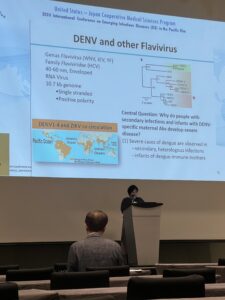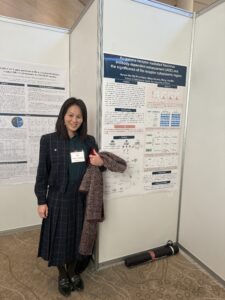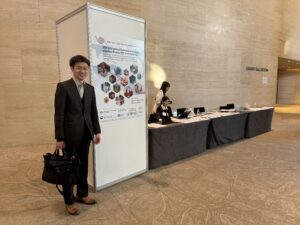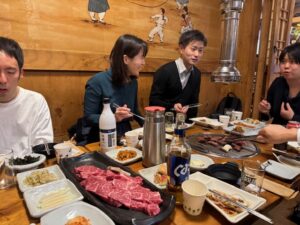The Joint 24th International Conference on Emerging Infectious Diseases in the Pacific Rim of the U.S.-Japan Cooperative Medical Sciences Program (USJCMSP) in collaboration with the 2nd International Symposium for Infectious Diseases Research Institutes Cooperation (IDRIC)
The 24th Joint International Conference on Emerging Infectious Diseases of the Pacific Rim of the Japan-US Joint Medical Sciences Program (USJCMSP) was co-sponsored by the 24th International Symposium on Infectious Disease Research Institutions Cooperation (IDRIC) under the Japan-US Medical Cooperation Program and was held in Incheon, South Korea from March 5th to March 8th, 2024.
Participants from our department are Professor Moi Meng Ling, Associate Professor Satoshi Taniguchi, and Assistant Professor Misao Himeno.
The Japan-U.S. Medical Cooperation Program (research project to promote the resolution of global health issues) was based on a meeting between then Japanese Prime Minister Eisaku Sato and then US President Lyndon Johnson in 1965, and the program progressed on to include the Asia Pacific (APAC) region. The purpose of this research program is to strengthen collaboration and research exchange between US-Japan on diseases that are affecting the APAC region.
Our department (Moi Laboratory) is a member of the “Viral Disease Subcommittee” of EID and has actively participated in USJCMSP EID activities for the past 15 years.
『日米医学協力計画』による、第24回感染症研究機関協力国際シンポジウム(IDRIC)との共催による日米共同医療科学プログラム(USJCMSP)の第24回環太平洋新興感染症に関する合同国際会議が、2024年3月5日から3月8日まで大韓民国・仁川にて開催されました。
当教室からの出席者は、モイメンリン教授、谷口怜准教授、姫野美沙緒助教です。
日米医学協力計画(地球規模保健課題解決促進のための研究事業)は、1965年の佐藤栄作総理大臣(当時)と、リンドン・ジョンソン大統領(当時)との会談に基づき、アジア地域にまん延している疾病に関する研究を日米両国で共有して行うことを目的としています。
当教室(モイ研究室)との関係は、本計画の「ウイルス性疾患部門会」に所属し「全専門部会」をまとめる部会長を務めていた、国立感染症研究所・倉根一郎元所長と、部会員を現在まで務めております。
==============================================
Abstracts of Presented Research:
Development of anti-HBV agents that contain alkaloidal scaffolds bearing Michael acceptors
Misao Himeno, Kaneko Nobuto, Hiroki Kubota, Taketomo Kido, Atsushi Miyajima, Masaya Sugiyama, Meng Ling Moi, Hiroki Oguri.
[Introduction] Hepatitis B virus (HBV) infection and its complications are estimated to kill 700,000 people each year all over the world. Complete elimination of HBV has not been achieved with existing treatment such as IFN therapy or nucleic acid analogs yet. Furthermore, these treatments have several problems including the requirement of long-term therapy with nucleic acid analogs, hepatitis flare caused by discontinued treatment, and the emergence of drug-resistant strains. Therefore, novel anti-HBV agent development which has different mechanisms of action is demanded.
[Methods] The purpose of this study is to identify new anti-HBV agents and elucidate their mechanism of action. As a largely underexplored approach to generate anti-viral covalent modulators, we focused on the indole alkaloidal scaffolds with Michael acceptors as the warheads. Based on the structural motifs of covalent drugs and natural products exhibiting antiviral activity, a series of nitrogen-containing skeletons bearing Michael acceptors were designed and synthesized. Synthesized agents were provided to HBV-replicating HepAD38 cells and HBV-infected HuH-7-NTCP cells. After two weeks of inoculation, HBsAg in cell culture supernatants and HBV relaxed circular DNA (rcDNA) levels were detected. Hit agents were provided for proteomic analysis.
[Results]Synthesized agents had a notably high hit rate and were found to exert potent in vitro anti-HBV activities, reducing viral load both in HepAD38 cells and HuH7-NTCP cells, with little cytotoxicity to hepatocytes. The proteomic analysis showed notable homologies between hit agents and HSP90 inhibitors. The binding of hit agent and HSP90 were detected as well.
[Conclusions] We found out several potent anti-HBV agents that contain alkaloidal scaffolds bearing Michael acceptors. The mechanism of action appears the inhibition of HSP90 activity.
The discovery of anti-HBV natural product-inspired covalent modulators with significantly higher hit rates than conventional small molecule screening demonstrates the potential of this proposed design and synthetic strategy to generate novel anti-viral chemical entities.
Substitution of E1497K in L protein changes plaque phenotype and growth kinetics of Guanarito virus S-26764 strain
Satoshi Taniguchi, Junki Maruyama, Takeshi Saito, Kirsten Littlefield, Rachel A Reyna, John T Manning, Cheng Huang, Masayuki Saijo, Slobodan Paessler
[Introduction] Guanarito virus (GTOV), a bi-segmented ambisense RNA virus, is the causative agent of Venezuelan hemorrhagic fever. GTOV belongs to genus Mammarenavirus, family Arenaviridae and has been classified as a Category A bioterrorism agent by the US Centers for Disease Control and Prevention. Despite being a high priority agent, vaccines and drugs against Venezuelan hemorrhagic fever remain to be developed. GTOV S-26764 strain, isolated from a non-fatal human case, shows unclear cytopathic effect (CPE) in Vero cells, posing a significant obstacle to research and development efforts. In this report, we aimed to generate Vero cell-adapted GTOV S-26764 and analyze its characteristics.
[Methods] GTOV strain S-26764 was passaged in Vero cells 17 times with 4-to 7-day intervals. The whole genome sequence of adapted GTOV (wtGTOV-VP17) was determined and compared with that of original strain S-26764 (wtGTOV). In vitro viral growth and plaque morphology of wtGTOV-VP17 were compared with those of wtGTOV. Recombinant GTOVs were generated by the reverse genetics system to characterize wtGTOV-VP17.
[Results] wtGTOV-VP17 showed clear CPE and high yield in Vero cells, compared to wtGTOV. Four amino acid changes [R346K and V484I in nucleoprotein (NP), and E1497K and I2057V in L protein (L)] were found in wtGTOV-VP17 genome. Recombinant GTOV possessing E1497K amino acid change in L showed clear CPE and high yield in Vero cells. Minigenome assay developed in this study revealed that E1497K amino acid change in L was involved in enhancing viral gene replication and transcription efficiency.
[Conclusions] Vero cell-adapted GTOV S-26764 capable of generating CPE will allow us to perform neutralization assays and anti-drug screening against GTOV. Moreover, the developed reverse genetics system will accelerate vaccine and antiviral drug development.
Fc-gamma receptor mediated flavivirus antibody-dependent enhancement (ADE) & the significance of the receptor cytoplasmic region
Nensar Wai Wai Phyo Rakwi, Misao Himeno, Meng Ling Moi
The internalization of virus-antibody complexes into Fc receptor-bearing cells serves as a critical step in antibody-dependent enhancement (ADE), thus enhancing viral replication and potentially exacerbating the severity of infection. This phenomenon has been observed in flavivirus infections, including dengue virus (DENV), Zika virus and Japanese Encephalitis (JE) virus. Interaction between the IgG Fc receptors and virus-bound antibodies are key in understanding the pathogenesis of flavivirus infections. In this context, the cytoplasmic region of FcγRIIA has been suggested to play an important role in ADE during DENV infection. To better understand the mechanism of antibody-dependent enhancement mechanism among flaviviruses in-vitro, we developed two stable cell lines which express the wild-type (WT) FcγRIIA and, an FcγRIIA that do not possess the cytoplasmic region (FcγRIIA/CT). Expression rate of the stable cell lines was determined by flow-cytometer and cell lines that stably expressed each receptor at >70% was used in the following experiments. By using conventional plaque assay, we determined the ADE activity of monoclonal antibodies, polyclonal antibodies, and patient serum by using non-FcγRIIA-expressing BHK cells, FcγRIIA-expressing BHK cells, and CT-expressing BHK cells against DENV, ZIKV and JEV. By using monoclonal antibodies, ADE activity against DENV and ZIKV was detected in both WT and CT cells, suggesting that the FcγR portion on cell surface is involved in ADE of flaviviruses. Interestingly, we found differential ADE patterns across flaviviruses, indicating diversity in the ADE levels between flaviviruses in the presence of non-neutralizing antibodies. Further analyses of global and cell-specific gene signatures will add significant depths into our understanding of the differential downstream signal transduction, in the presence and absence of the FcγRIIA cytoplasmic region and, to identify the mechanisms responsible for modulating ADE across flaviviruses during natural infection and vaccination.
Identifying novel pipelines for surrogate of protection against DENV: Longitudinal analysis of Dengue virus-1 (DENV-1) infection induced cross-neutralization and antibody-dependent enhancement activity across genotypes levels and T-cell epitopes
Moi Meng Ling, Yukio Nakamura, Ryuji Suzuki.
Arbovirus infection remains as one of the major public health threat in tropical and subtropical regions. Infection with vector-borne arboviruses such as dengue virus (DENV), Zika virus (ZIKV), and Japanese Encephalitis virus (JEV) has been associated with severe clinical symptoms. As such, the determination of the extent of arbovirus outbreaks is of particular importance in these regions. With our cohort studies across Myanmar, Vietnam and Malaysia, we found introduction of new genotypes and changes in outbreak patterns of DENV, ZIKV and other arboviruses outbreaks across Southeast Asia. Using our FcγR-expressing BHK cells that determines both infection enhancing activity and neutralizing activity, and longitudinal cohort samples, we demonstrated waning neutralizing activity against homologous and heterologous genotypes in dengue patients and, lower neutralization activity against newer genotypes. While neutralizing antibody activity wanes over a period of one year, using B-cell receptor sequencing readouts, we found that IgM and IgG clones were moderately induced despite lower antibody levels as determined in-vitro. Using the B-cell receptor readouts and epitope prediction pipeline, in clinical samples, we found that T-cell epitopes corresponding to the infective serotype and genotypes sequences were present in convalescent patient samples, suggesting that cellular immunity may be key in heterologous immune response across DENV genotypes and serotypes in endemic settings. These findings will be useful for future DENV and flavivirus vaccine development and control measures in the region.




Information exchange with US-Korea-Japan counterparts, Korean BBQ
Funding: AMED 日米医学協力計画 地球規模保健課題解決促進のための研究事業




